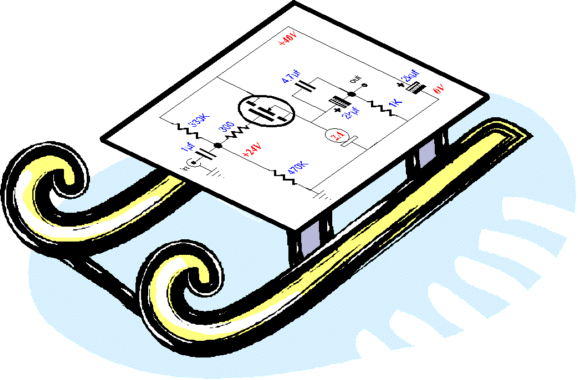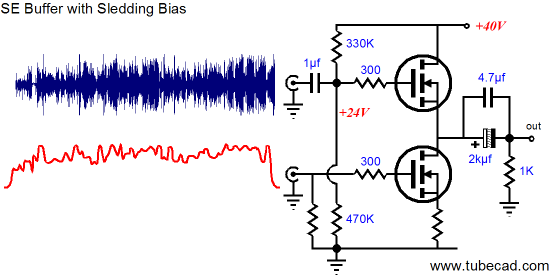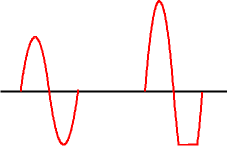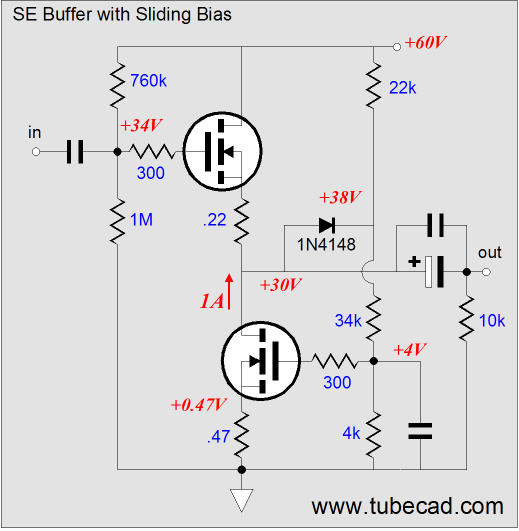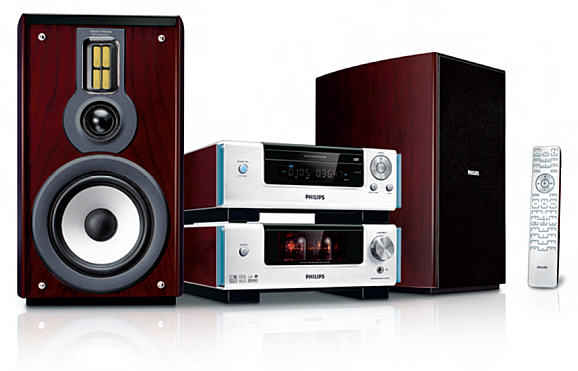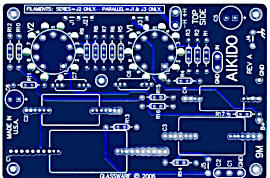| John Broskie's Guide to Tube Circuit Analysis & Design |
|
22 November 2007
Earth-Friendly Class-A and Sledding Bias When you want it all, do not be surprised that you get less than you expected—often much less. We want a great-sounding MP3 player and we want it to play for days on one charge. Alas, a lithium-ion battery can only deliver so much energy between chargings. So, an MP3 player maker will try every trick to get more playing time out of the battery. Eventually, they will discover that class-B headphone amplifiers drain the least from the battery. Thus, the playback time goes up, but the sound quality goes down; but the playback time can readily be measured and the sound quality cannot—so we get more playback time and worse sound. Now, imagine if you had a choice: you could choose between 14 hours of push-pull, class-B operation or 7 hours of single-ended, class-A operation. I know which I would choose. Unfortunately, we are not given the choice. Eventually, some enterprising fellow will offer modified iPods, iPods retrofitted with tantalum-nitride surface-mount resistors, a better headphone amplifier (and an external coupling capacitor enclosure that holds $700 exotic bypass capacitors and Blackgate electrolytics). A steal at only $2,400. Until such a glory is realized, I would be happy to have just a single-ended headphone amplifier in my Zune and a reduced playback time. If only there were a way to have both high efficiency and single-ended grandeur. Well, this is where the opening metaphor comes back into play.
My idea is a simple one: slowly vary the idle current on the single-ended output stage to meet the demands of the music being played back. When the music pauses or falls into a near-silent pianissimo, let the idle current fall to a diminutive trickle; but just before it swells to an ear-bleeding crescendo, let the idle current climb to a near-dangerously high torrent. In other words, use only the amount of idle current that is needed to trace the music signal at the desired volume level. For 32-ohm headphones, the range of current variation would span from, say, 2mA to 35mA per channel, as 35mA would ensure that at least 1-volt output swings could be delivered into 32 ohms. For a 60W power amplifier working into an 8-ohm load, the idle current variation would span from 20mA to 4A per channel.
Now all we have to do is devise a method to fluctuate the idle current through the headphone amplifier’s single-ended output stage in accordance with the anticipated music signal and playback level. Wait minute; this is crazy, as it would be easier to devise a method to buy and sell stock in accordance with the rise and fall of the Dow-Jones average—before we know what the average is! No circuit can know what the music signal is going to look like before it happens. True enough, as far as simple analog circuits and live music are concerned, but an MP3 player and any other hard-drive-based or RAM-based music system can know what is coming, as it holds the information in its memory. In other words, we know where the future information resides; we just have to find a way to read it ahead of time. We could hold up the music stream for 10 seconds in a RAM buffer, which is what portable CD players do to overcome the skipping comes from vigorous jogging. Or we could try a method that does not require so much computation. Imagine that when a music file is being ripped, a second small file is also being created. This tag-along file would hold the outline shape of peak signal magnitude through the ripped file. In other words, the secondary file would record the level of require idle current for playing back the primary ripped MP3 or WMA file. Just as drawing a springtime landscape filled with rocky hillsides, flowering trees and shrubs requires much skill and much ink, creating an MP3 or WMA file requires powerful computations and vast memory space. But drawing a completely snow-capped landscape requires much less talent and little ink. Likewise, tracing the smoothed-over outline of peak current demand would be a relatively simple and small undertaking. This secondary current map file would consist of only two running streams of numbers: the passing time in seconds and the averaged peak current magnitude. Think of it as down-sampling in the extreme, as the 44kHz sampling rate would be converted down to 1Hz sampling; and the 16-bit length reduced to 8 bits. A very small file indeed. At playback, both files would be loaded into memory and both would be played simultaneously, with the secondary current map file being accessed every second for an idle current update reading. For example, below is an amplitude snapshot of a few minutes of Latin soul music by Alma Rosa.
The hard drive file that held the musical sample was about 25Meg big. On the other hand, a peak-current map file of this music recording would be no larger than a GIF file of the image below: 5k. In other words, the hard drive or flash memory card will not be overstuffed with extra data files.
(By the way, just as JPG images can be embedded in MP3 files, the peak-current map file could be also be embedded.)
Think feedforward, not feedback; think anticipatory, not reactive. Since we now know what the future holds for the amplifier’s output stage, we can slowly vary its idle in accordance with the projected demand. A proactive amplifier, as we would say in modern parlance. Now, if the amplifier saw that the volume setting raised or lowered, the idle current scaling would, in turn, rise or lower in anticipation of the coming demand. Because the shift in idle current is so slow, it would fall outside of our hearing range, as the highest frequency that could be reproduced with 1-second sampling is ½Hz, which not even the biggest, sassiest subwoofer can reproduce and which only the highest-paid audio reviewers can hear. By the way, this sledding-bias method could also be applied to class-A, push-pull amplifiers. In fact, the increase in efficiency might be so great as to make the move to class-D unnecessary.
Before-It-Happens Clipping Indicator
Some amplifiers hold clipping indicator LEDs, which flicker during clipped signals. Of course, for the lights to flicker, the amplifier must clip first, as the indicator circuit is only reactive. Now, what if the clipping indicator light were to come on before the amplifier clipped? We could then turn down the volume until the light went out. With the peak-current-demand map, an early clip indicator would be easy enough to implement. Such a system would not have to rely on a sledding-bias arrangement, as any amplifier could be used, as long as it had a way of knowing beforehand the peak wattage into the loudspeakers being driven.
Sliding Bias Before moving on to the circuitry, let’s review the relationship between idle current and peak power output in a single-ended amplifier. The idle current sets the limit on peak symmetrical power output (with sinewaves) according to the following formula: Wattage = Iq² x Rload/2 For example, a triode-based single-ended amplifier with a primary impedance of 3k and an idle current of 100mA will, if correctly designed, deliver 15W into the primary and a bit less into the loudspeaker (due to losses in the windings and transformer core). The key word was “symmetrical,” as this single-ended amplifier can deliver many more distorted, unsymmetrical watts.
Of course, the positive going voltage swing cannot extend into infinity, as the output stage will reach a voltage limit in that direction. (In contrast, push-pull amplifiers run into voltage limits symmetrically.) Now, we can move on to a sliding-bias single-ended-amplifier output stage. The general idea is to run a single-ended amplifier leanly at idle, but then, as the music makes greater demands on the amplifier, the idle current will tag along, swelling with the crescendos, relapsing with the pauses.
In the above schematic, we see my old style of drawing schematics because this is an old drawing of mine. In addition, we see a single-ended MOFET buffer stage. With a 60V B+ voltage, this single-ended amplifier could deliver as much as 40W into 8 ohms. Its 1A idle current, however, limits its symmetrical power output to 4W into 8 ohms. (Many 300B-based single-ended amplifiers do not deliver 8W, so this example is not that heat-saving, as at least 120W will be dissipated by a stereo amplifier at idle. Still, 120W is better than 360W that a conventional 36W class-A single-ended amplifier would dissipate at idle.) Once the output voltage swing exceeds 8.7V, the bias voltage on the bottom MOSFET's gate will increase. At maximum output power, the idle current will triple to 3A, allowing 36W of symmetrical output to be delivered into 8 ohms. (As a preemptive move, let me state that yes, the Aikido could drive such a buffer. But let me also state that the resistor values were picked merely for design illustration and that a lot of design work remains to be done before a finished power amplifier can be made. Remember that this blog aims to educate and to intellectually strengthen the reader, not to offer tested recipes. Second, I must mention that this technique can be applied to conventional, tube-based single-ended power amplifiers, although we must be careful not to run the cathode current too low, as to do so will risk tube sleeping disease, due to an insulation build up at the cathode interface.)
MCD908
To my ear, this sounds like the result you get when a software program translates English into Chinese and then back to English. My favorite sentence is “Vacuum tube is not something new, but always a premium.” (Can’t you see it printed on a T-shirt…well, maybe a T-shirt worn in Thailand or Japan.) And it looks like "HiFi Tube" is now a registered trademark ®™.
What is being described is a Philips DVD Micro Theater MCD908, which is a cute little DVD/CD player and amplifier and speaker system. I found it at the Sharper Image website by accident. The system sells for as little $399 (www.newegg.com) and it boasts some interesting features beyond the inclusion of tubes.
Tubes, class-D, ribbon tweeters, loudness and treble and bass controls, HDMI output, DivX, Dolby Digital…“noble materials,” no less. Not bad. Note how the gold-plated speaker connections are listed before the 75W of output. Okay, JRB, I’ll admit the tubes make a nice LED replacement, but why should I, a true-pure-tube-loving guy, care? Three things make me care. The first is that I was in an electronics store a few months ago and I overheard two fellows talking about a Philips small stereo system. The fellow who had bought the under-$200 unit told his friend that he was shocked by how good it sounded. He said that he hadn’t expected much, but he was thrilled by the sound that came out of the little system, so much so that while he had oiriginally intended to keep the system in his garage, it now lived in his bedroom instead. I didn’t catch the model number and I just made a mental note to look into Philips mini systems. Second, I have listened to one NXP class-D amplifier before and loved the sound. NXP was kind enough to send me a TDA8920B reference-design board for evaluation. The TDA8920B class-D amplifiers sound amazingly tube-like.* Third, I have corresponded with a few of the electrical engineers at NXP and I have been impressed by their attitudes and goals. In fact, the audio division at NXP even harbors at least one Aikido amplifier enthusiast.** Thus, I very much doubt that the tubes are just LED replacements. Still, I haven’t heard the Philips DVD Micro Theater MCD908, so I cannot say much more than it might make a killer complete mini entertainment system (just add a HDMI LCD Monitor and, maybe, subwoofer) for a small apartment or bedroom. (I tried to find out in the MCD908 user manual which tubes are used in the MCD908, but no luck. And while I am at it, I would love to see the schematic to the unit. But, most of all, I would love to hear it.)
//JRB
*TDA8920B Running this class-D amplifier in balanced/differential-output mode, however, was a major disappointment—all the sonic glory was gone and the amplifier sounded no different from any other solid-state amplifier. This makes sense, as the balanced output kills all the even-order harmonics, while accentuating the odd harmonics. Never a good idea. (But I just might have the solution: if I reconfigure the two amplifiers in the seemingly wrong way, they may preserve the even-harmonic distortion signature.) I have come up with a simple arrangement that allows switching the output inductors and shunting capacitors to suit the intended load impedance. With one three-position, four-pole rotary switch and a handful of inductors and capacitors, you can select 4, 6, and 8-ohm loads for both channels. (The 8-ohm load values are permanently soldered in place, and selected inductors and capacitors are placed in parallel to get the right values; In other words, two 47uH and one 33uH inductor are used, as are two 330nF and one 470nf capacitors.) I want to experiment with air-core inductors on the output. In addition, I would love to try an autoformer on the output, so that the 100W output could be realized into 8-ohm loads. In fact, it would be interesting to try both channels placed in parallel with a 0.22-ohm series resistor for each amplifier working into the same autoformer, so that 200W could be developed. My bet, however, is that until the operating frequency is raised even higher, no class-D amplifier will shine in the high-frequencies. Nonetheless, these amplifiers would be perfect in a bi-ammped or tri-ampped setup, wherein they never went over 6kHz. Thereafter, a high-quality tweeter with a 3W single ended tube amplifier would play plenty loud. I haven't mentioned the TDA8920B before because I did all my listening and testing with a regulated bipolar power supply that can deliver 5A of output current and I do not know how well the amplifier would work with a conventional un-regulated power supply.
**An additional Aikido fan was been revealed at NXP since I first posted this entry.
|
High-quality, double-sided, extra thick, 2-oz traces, plated-through holes, dual sets of resistor pads and pads for two coupling capacitors. Stereo and mono, octal and 9-pin printed circuit boards available. Aikido PCBs for as little as $24 http://glass-ware.stores.yahoo.net/ Only $12.95 Download or CD ROM www.glass-ware.com
|
|||
| www.tubecad.com Copyright © 1999-2007 GlassWare All Rights Reserved |
